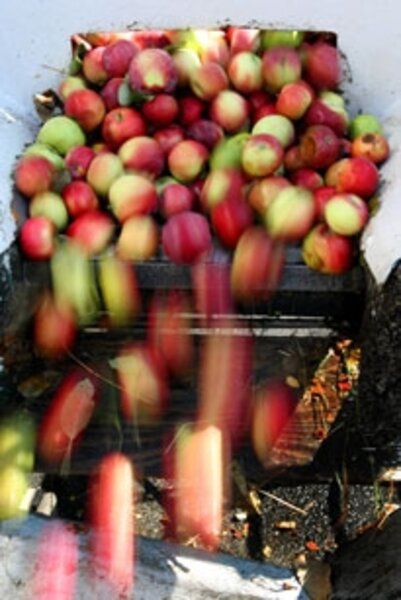Apple tree goodness, from bough to fruit
Loading...
Last year, all through the winter, a lone apple hung on its branch, gracing the view outside the window of the church I attend in the little Maine village where I live.
It seemed to be there just for me – a stark but lovely still life composed of a single, deep-red apple posed on its angular branch against the dusty green clapboard of the neighboring house and perfectly framed by the modest square church window.
Somehow its tenacity through wind and snow testified to the enduring sturdiness of the apple, that marvelous creation of core, seeds, and meat wrapped tidily in crisp skin.
My fondness for the apple began in childhood when I lived in a house built on the site of an old apple orchard. In late summer and throughout the fall, we were blessed with a bounty of McIntosh, Gravenstein, and Baldwin apples. I considered us rich beyond words.
Each tree had its own unique features. The “Mac” was excellent for climbing. The Gravenstein had a perfect bough for doing backward and forward somersaults, a daring feat for timid me.
But perhaps the tree that spoke most eloquently to me was the Baldwin. The Baldwin was also the last tree to bear, making its fruit even more highly prized.
Sitting in my room doing my homework in the fall, I would look longingly out the window at the apples that drew down the branches of that tree with their sweet bounty.
My reward for completing an hour’s worth of homework was to go down the stairs and out the back door to retrieve a hard, cidery tasting Baldwin, the quintessence of autumn.
When I grew up, my fondness for the apple found practical expression in Max’s Connecticut orchard where I joined a retired banker, an unemployed construction worker, and other housewives in helping to harvest the apple crop.
At the end of the workday, Max let me fill the trunk of my car with “drops,” those apples that had fallen off the trees and were possibly bruised as a result. These I distributed among neighbors, who gratefully received them with strands of grass, damp leaves, bruises, and all.
I cooked down my share, spooning the hot, pink sauce into plastic containers. Its steamy fragrance drifted from room to room, permeating the house and luring the family to the kitchen for a bowl of warm applesauce with cream and an oatmeal cookie.
I would freeze the remainder of that day’s sauce, knowing that I would be making more the next day and the day after, guaranteeing us the taste of the apple harvest throughout the cold winter months to come.
Even today a vintage roadside apple tree holds the same lure for me. I am not fooled by its almost bare branches because I know that nestled in the leaves beneath its boughs can be found crimson beauties that will produce a batch or two of applesauce.
How sweet is the taste of those that have survived an early frost snug in their leaf nests under the tree.
To make applesauce, I simply put the cooked apples through the Foley Food Mill – no sugar, no cinnamon, no lemon juice.
However, I do occasionally serve it with a blob of commercial sour cream on top, sprinkled with brown sugar.
For an apple pie taste, a family favorite is applesauce with a dash of cinnamon spooned over vanilla ice cream and complemented with a plate of oatmeal cookies straight from the oven.





